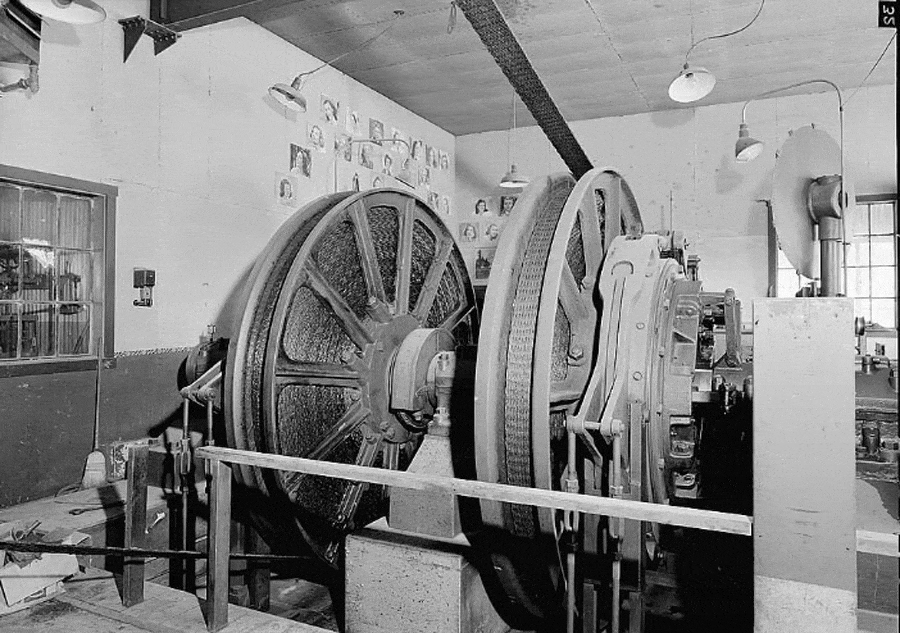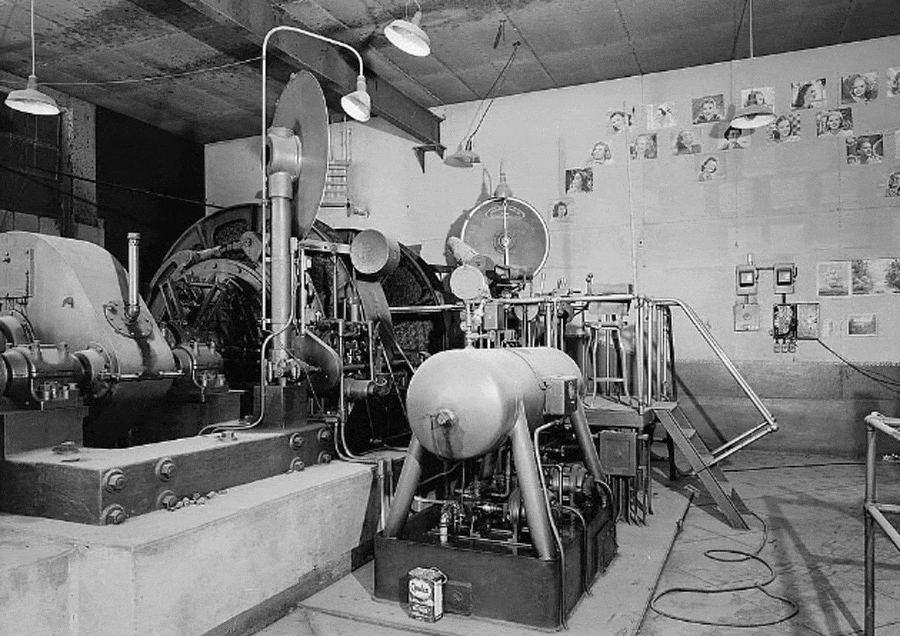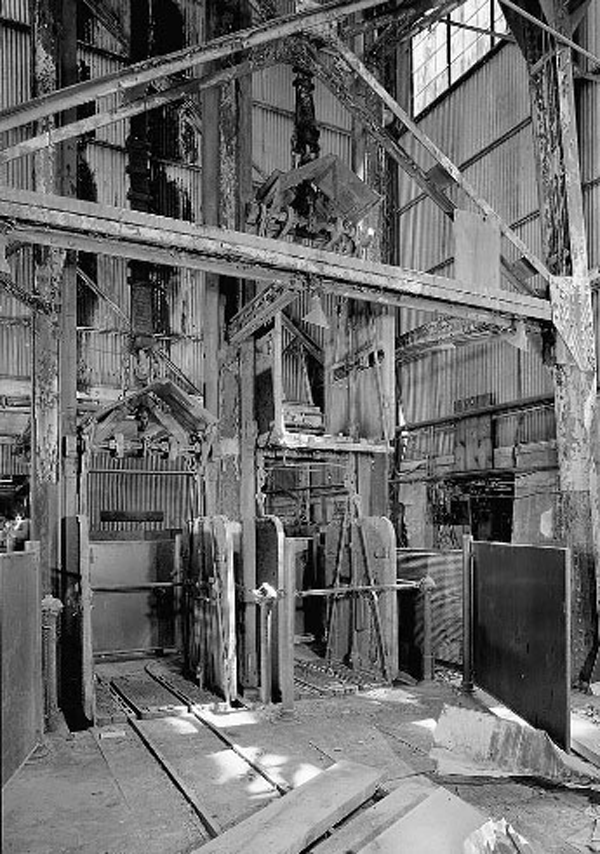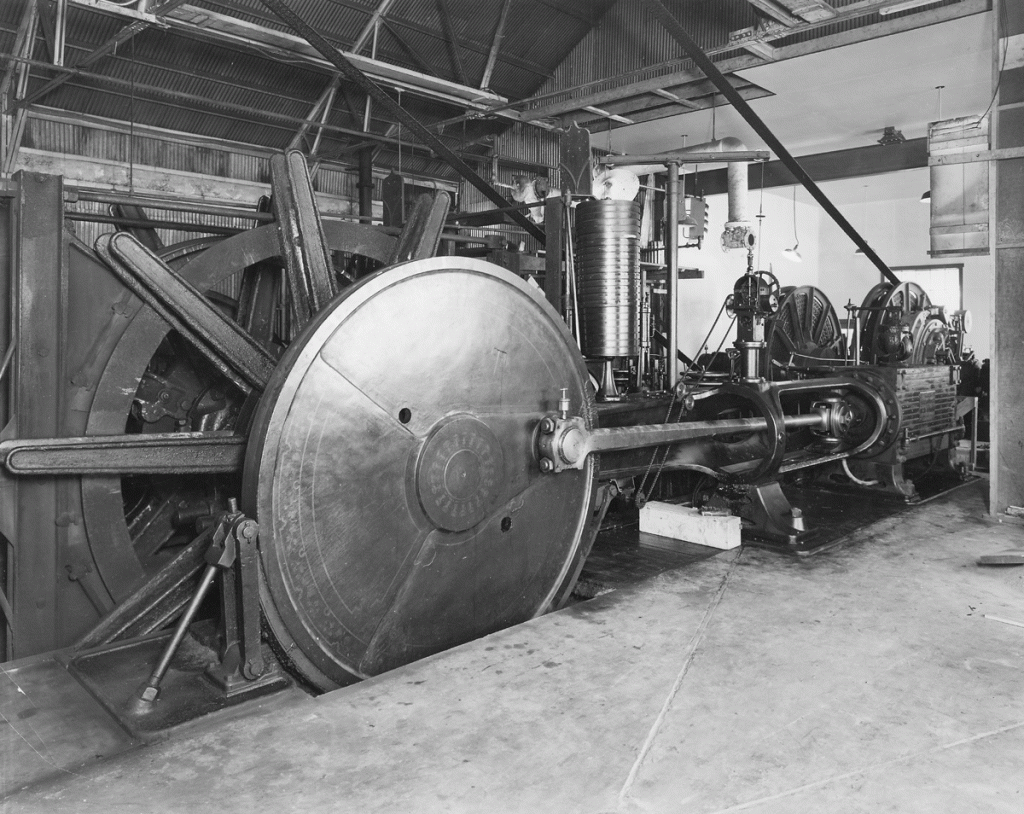Each of the mine shafts in the Park City area were fitted with hoisting equipment to raise and lower the men and materials in the shafts. At the Silver King Mine, the earlier hoists were all powered by steam engines and the later hoists had electric motors.
The old hoisting equipment was built by the Bullock Manufacturing Company. It was a double-reel, flat wire rope hoist powered by a 1,000-horsepower Corliss steam engine and was state-of-the-art when installed in 1893. The steam engine had two 20-inch diameter cylinders connected to flywheels that were connected to the hoist reels. The steam was provided to the engine at 100 psi from three double boilers burning coal that was transported up the same Silver King aerial tramway that moved ore and concentrate down from the mine. Exhaust steam from the hoist engine was used for space heating in the mine building, offices, bunk houses, mill, and other buildings at the Silver King Coalition Mines Company property. Reportedly, the steam-powered hoisting equipment served the mine with very little trouble for 44 years.
In the mid-1930s the company realized the condition of the boilers and hoisting equipment was getting to the point where they needed to be replaced to continue steam hoisting operations. They determined that the estimated capital and operating costs favored replacing the steam hoisting system with electrical equipment.
The new electric system was manufactured by Nordberg Manufacturing Company. It was a double-reel hoist coupled to a 400-horsepower, 2,300-volt electric motor with a single reduction gear. The hoist was normally operated in a “balanced” mode where one double cage was lowered in the shaft while the other cage was simultaneously raised. This was accomplished by the two hoist cables being wound on the reels in both “overhand” and “underhand” configurations as shown in Photograph 1.

Credit: Park City Historical Society & Museum
However, each reel could also be operated independently through a friction clutch arrangement. The brakes and clutches were operated hydraulically with a pressurized oil system co-located with the hoist. Photograph 2 shows the new hoist in operating condition with the hydraulic accumulator and pressure tank (the horizontal tank) at the back of the hoist.

Credit: Park City Historical Society & Museum
The main shaft served by the hoist was 1,325 feet deep with two compartments for cages and one service compartment. There were six operating levels in the shaft, but the bulk of the ore production in the shaft when the new hoist was installed occurred at the 500-foot and 1,300-foot levels. All rock was hoisted in mine cars via double-deck cages shown in Photograph 3.
The new hoist could raise a loaded cage from the 500-foot level in 21 seconds and from the 1,300-foot level in 48 seconds, accelerating to full speed with a full load in 10 seconds. The hoisting speeds were reduced when men were being transported. The new hoist incorporated multiple safety controls to avoid excess speed, over-winding, and over-running. It was considerably easier and less hazardous to operate than the fully mechanical controls of the former steam powered hoist.

Credit: Park City Historical Society & Museum
Because all the ore produced in the mine was raised in the main shaft, it was necessary to minimize the timeframe required to switch operations over from the steam to the electric hoists. They determined to continue operations with the flat wire ropes fitted to the original hoist instead of switching to more modern, round wire ropes for the new hoist. When the new hoist was ready for operation the flat wire ropes were transferred from the old hoist reels to the new hoist reels with minimal down time for the shaft.
Photograph 4 is from sometime after March 1937 when a new electric hoist was placed in service at the main shaft for the mine. This picture shows the old steam powered hoist in front and the wire ropes leading back to the electric hoist in back. As can be seen, the old hoist had flywheels for the steam engine cylinders and large rope reels (empty in the picture) that extended below the floor into a masonry pit. When the old hoisting equipment was removed, this pit was covered with a wooden plank floor that remains today. The Nordberg hoisting equipment that was installed in 1937 operated until mining operations ceased in the early 1950s. The equipment essentially remains in its 1950s configuration today.

Credit: Park City Historical Society & Museum, Jordanelle Special Service District Collection